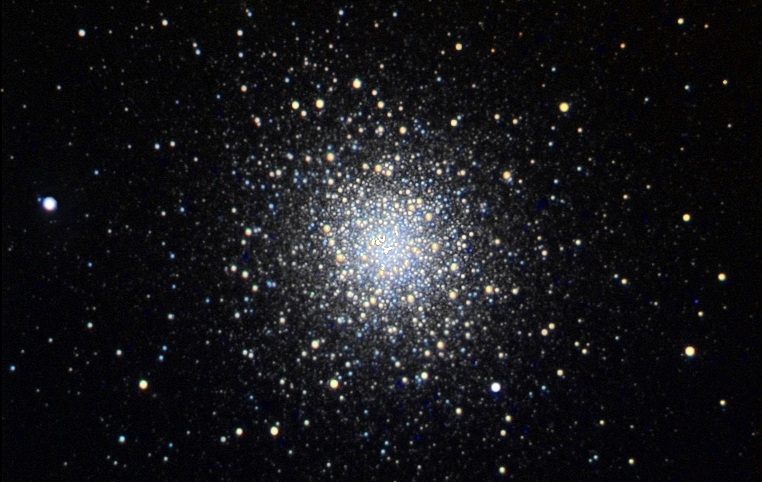|
|
|
Instrument |
12.5" RCOS @
~f/9 (2880 mm fl) 0.64 arcsec / pixel. The Zoomify image scale
is 0.85 to 2.55 arcsec / pixel. |
|
Mount |
Paramount ME |
|
Camera |
SBIG STL-11000 w/ internal filter wheel, AstroDon Filters |
|
Acquisition Data |
5/9/2010 to 5/13/2010 Chino Valley, AZ... with CCDAutoPilot3
& CCDSoft. AOL guided |
|
Exposure |
Lum (no filter) 120 min (24 x 5 min, bin 1x1)
RGB
195 min (13 x 5 min each, bin 2x2)
|
|
Software |
-
CCDSoft, CCDStack,
Photoshop CS w/ the Fits Liberator plugin, Noel Carboni's actions
and Russell Croman's GradientXTerminator.
-
eXcalibrator for (u-g), (g-r) color calibration, using 13 stars from
the SDSS-7 database.
-
PixFix32 (pre-beta) to
repair hot/cold pixels and column defects.
-
CCDStack to calibrate,
register, normalize, data reject, combine the sub exposures,
luminance deconvolution and LRGB
color.
-
PhotoShop for LLRGB
combine &
on-linear stretching.
|
|
Comment |
North is to the top.
The globular cluster, M92, contains roughly 50,000 to 100,000 stars.
These stars formed together and are gravitationally bound. Stars
orbit the center of the cluster, and the cluster orbits the center
of our Galaxy.
About 160 globular clusters are known to exist in a roughly
spherical halo around the galactic center. Globular clusters do not
appear spherically distributed as viewed from the Earth, and this
fact was a key point in the determining our Sun's location in our
Galaxy.
Globular clusters are very old, with M92 being one of the oldest at
a computed age of 16 billion years. Its diameter is about 109
light-years and at a distance of 26,700 light years, this diameter
is about 14 minutes of arc. M92 is located in the constellation
Hercules
Source: NASA APOD & SEDS
|
════════════════════════════════════════
M92 -
2005 Version

|
Instrument |
Celestron C11 @ F/6.1
(1705 mm) 1.087 arcsec / pixel |
|
Mount |
Losmandy G11 |
|
Camera |
SBIG ST-7 with
CFW-8A color wheel |
|
Acquisition Data |
7/9/05 to 7/13/05
Near downtown Seattle |
|
Exposure |
Lum
60 min (12 x 5 min)
Red 40 min (8 x 5, bin 2 x 2)
Green 40 min (8 x 5, bin 2 x 2)
Blue 60 min (8 x 7.5, bin 2 x 2) |
|
Software |
CCDSoft, FocusMax,
PhotoShop CS, The DitherMat was used to dither the luminance
layer. |
|
Comment |
North is to the
top. |
|